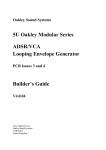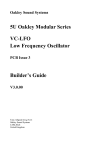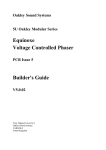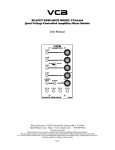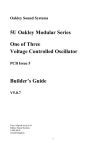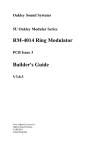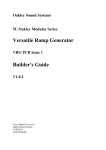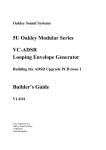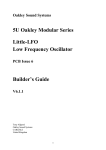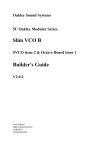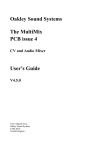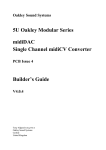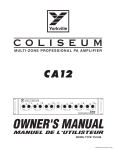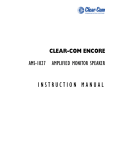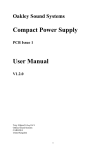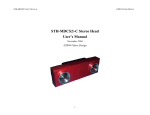Download Builder`s Guide for EFG issue 6
Transcript
Oakley Sound Systems 5U Oakley Modular Series EFG & EFG-Deluxe Envelope Follower & Gate Extractor PCB Issue 6 Builder’s Guide V6.0.2 Tony Allgood B.Eng PGCE Oakley Sound Systems CARLISLE United Kingdom Introduction This is the Project Builder's Guide for the issue 6 EFG and EFG-Deluxe modules from Oakley Sound. This document contains a full parts list for the components needed to populate the board and gives details on how to wire up the module in either of its guises. For the User Manual, which contains an overview of the operation of the unit, please visit the main project webpage at: http://www.oakleysound.com/follower.htm For general information regarding where to get parts and suggested part numbers please see our useful Parts Guide at the project webpage or http://www.oakleysound.com/parts.pdf. For general information on how to build our modules, including circuit board population, mounting front panel components and making up board interconnects please see our generic Construction Guide at the project webpage or http://www.oakleysound.com/construct.pdf. 2 The Issue 6 EFG PCB This is the prototype of the issue 6 standard EFG module behind a natural finish 1U wide Schaeffer panel. Note the use of the optional Sock4 socket board to facilitate the wiring up of the six sockets. On the EFG printed circuit board I have provided space for the four main control pots. If you use the specified 16mm Alpha pots and matching brackets, the PCB can be held very firmly to the panel without any additional mounting procedures. The pot spacing on this board is the standard Oakley spacing of 1.625”. The design requires plus and minus 15V supplies. The power supply should be adequately regulated. The current consumption is around +48mA and -38mA for the EFG-Deluxe and slightly less for the EFG. Power is routed onto the main PCB by either a four way 0.156” MTA156 type connector or the special five way Synthesizers.com MTA100 header. You could, of course, wire up the board by soldering on wires directly. The four pins are +15V, ground, earth/panel ground, -15V. The earth/panel connection allows you to connect the metal front panel to the power supply’s ground without it sharing the modules’ ground line. The main PCB has four mounting holes for M3 bolts, one near each corner. These are not required for panel mounting if you are using the three 16mm pot brackets. The board size is 107mm (deep) x 143mm (high). The main board has been laid out to accept connection to our Sock4 socket board. This small board speeds up the wiring of the sockets and reduces the chances of building mistakes. Two such boards are required with the EFG-Deluxe. 3 Issue 6 EFG and EFG-Deluxe Parts Lists For general information regarding where to get parts and suggested part numbers please see our useful Parts Guide at the project web page or http://www.oakleysound.com/parts.pdf. The module may be built as one of two variants. There are significant differences between the two builds. To make things easier I have provided two sets of parts lists, one for the EFG and one for the EFG-Deluxe. Take careful note of the various links fitted to the board as not getting this right will lead to much confusion. In the parts lists the components are grouped into types and then values. The order of the component names, R1, C1, etc. is of no particular consequence. A quick note on European part descriptions. R is shorthand for ohm. K is shorthand for kiloohm. R is shorthand for ohm. So 22R is 22 ohm, 1K5 is 1,500 ohms or 1.5 kilohms. For capacitors: 1uF = one microfarad = 1000nF = one thousand nanofarad. To prevent loss of the small ‘.’ as the decimal point, a convention of inserting the unit in its place is used. eg. 4R7 is a 4.7 ohm, 4K7 is a 4700 ohm resistor, 6n8 is a 6.8 nF capacitor. A close up of the lower part of the EFG standard version showing two of the three links. You can see the links in pins 2 and 3 of LK2, and pins 7 and 8 of I/O_2. 4 1. EFG Parts List Resistors 1% 0.25W metal film types are to be recommended simply because they are better quality and lower noise components. However, 5% ones can be substituted in most of the places if you wish. The 3M3 resistors will probably have to be a 5% type since getting hold of a 1% metal film resistor in this value is not trivial nor worthwhile in this case. 10R 22R 75R 100R 150R 510R 820R 1K 1K5 1K8 2K 3K 4K7 7K5 10K 12K 15K 18K 20K 22K 27K 30K 39K 47K 100K 220K 470K 1M 3M3 R25, R21 R37, R38, R33, R35 R59, R17 R29 R18, R7 R41, R54, R44, R57 R22 R31, R28, R4 R9 R10 R5, R23 R19 R8 R74, R73 R39, R1, R27 R20 R30 R3, R16 R6 R46 R26 R55, R40, R42, R53, R56, R45, R43, R58 R12 R61, R60, R72 R13, R63, R62, R36, R70, R47, R14, R71, R2, R64, R49, R48, R50 R11 R24, R32 R34 R15 Capacitors 22pF C0G 2.5mm ceramic 100pF COG 2.5mm ceramic 560pF* C0G 2.5mm ceramic 680pF C0G 2.5mm ceramic 10nF polyester film box C4, C14 C5, C38, C15 C40, C26, C41, C27 C30, C37, C31, C36 C8 5 100nF multilayer axial ceramic 680nF polyester film box 1uF polyester film box 2u2, 63V electrolytic 22uF, 35V electrolytic 47uF, 35V electrolytic C32, C35, C33, C47, C9, C34, C46 C17, C28 C18, C19, C1, C24 C39, C29 C21, C22, C10, C11, C16, C6, C7 C3, C13, C25, C12, C20, C2 * 470pF may be used in place of 560pF. Potentiometers (Pots) Pots Alpha 16mm PCB mounted types: 47K or 50K linear 10K dual (stereo) linear FREQUENCY, THRESHOLD, RESPONSE GAIN Three 16mm pot brackets. LEDs 5mm red round LED 5mm orange round LED 5mm green round LED PEAK ENV GATE Three LED clips for front panel and three LED securing rings if required. If using my suggested way of wiring up the LEDs you will also need three two way 0.1” Molex style housings and six crimps. Discrete Semiconductors 1N4148 signal diode 1N5819 Schottky power diode BC550 NPN small signal transistor BC560 PNP small signal transistor D1, D2, D3, D4, D5, D6, D7, D8, D9, D12, D13 D18, D19 Q1, Q2, Q4, Q5 Q3 Integrated Circuits OP275* dual audio op-amp SSM2164 or V2164 quad VCA TL074 quad FET op-amp U1, U2 U5 U3, U4, U6 DIL IC sockets are to be recommended. You need two 8-pin, three 14-pin and one 16-pin sockets. 6 * For the pre-amplifier any good dual op-amp can be used. Decent enough performance can be had even with a TL072 or LF412. Switches SPST or SPDT toggle switch X10 Miscellaneous Leaded axial ferrite beads L1, L2, L3 MTA156 4 way header MTA100 6-way header PSU PWR – Oakley/MOTM power supply – Synthesizers.com power supply Molex/MTA 0.1” header 6-way Molex/MTA 0.1” housing 6-way I/O_1 I/O_1 – for connecting to sockets – for connecting to sockets Wire Links These are made either from resistor lead clippings or thin solid core wire. 1. LK is linked. LK is found between R24 and R33. 2. On LK2 use a single link to connect pins 2 and 3 together. Pins 1 and 4 have nothing inserted. 3. On I/O_2 pins 7 and 8 are linked. Components required if using the optional Sock4 board Molex/MTA 0.1” header 8-way Molex/MTA 0.1” housing 8-way I/O on Sock4 I/O on Sock 4 112APC Switchcraft 1/4” socket SK1, SK2, SK3, SK4 on Sock 4 L1 and L2 are left open and no links are fitted to the Sock4 PCB. If using Molex KK you'll also need at least 32 crimp terminals. Suitable lengths of wire to make up one single 100mm interconnect. 180mm of thin screened audio cable. A single cable tie may be needed. See later for details. 7 2. EFG-Deluxe Parts List Resistors 1% 0.25W metal film types are to be recommended simply because they are better quality and lower noise components. However, 5% ones can be substituted in most of the places if you wish. The 3M3 resistors will probably have to be a 5% type since getting hold of a 1% metal film resistor in this value is not trivial nor worthwhile in this case. 10R 22R 75R 100R 150R 510R 820R 1K 1K5 1K8 2K 3K 4K7 7K5 10K 12K 15K 18K 20K 22K 27K 30K 39K 47K 100K 220K 470K 1M 3M3 R25, R21 R37, R38, R33, R35 R52, R59, R17 R29 R18, R7 R41, R54, R44, R57 R22 R31, R28, R4 R9 R10 R5, R23 R19 R67, R68, R8 R74, R73 R51, R39, R1, R27 R20 R30 R3, R16 R6 R65, R46 R26 R55, R40, R42, R53, R56, R45, R43, R58 R12 R61, R60, R72 R13, R63, R62, R36, R70, R69, R47, R14, R71, R2, R64, R49, R48, R50 R11 R24, R32 R34 R66, R15 Capacitors 22pF C0G 2.5mm ceramic 100pF COG 2.5mm ceramic 560pF* C0G 2.5mm ceramic 680pF C0G 2.5mm ceramic 10nF polyester film box C4, C14, C42 C5, C38, C15 C40, C26, C41, C27 C30, C37, C31, C36 C8 8 100nF multilayer axial ceramic 680nF polyester film box 1uF polyester film box 2u2 polyester film box** 2u2, 63V electrolytic 22uF, 35V electrolytic 47uF, 35V electrolytic C32, C35, C33, C47, C9, C34, C46 C17, C28 C18, C19, C1, C24 C43, C45 C39, C29 C21, C22, C10, C11, C16, C6, C7 C3, C13, C25, C12, C20, C2 * 470pF may be used in place of 560pF. ** C23 and C44 are normally left empty when using 2.2uF capacitors in positions C43 and C45. However, 2.2uF is quite a large value and you may not be able to obtain it from your supplier. In this case simply use four 1uF polyester film caps in positions C23, C43, C44, C45. Should you wish to achieve longer lag times you may wish to populate all four positions with 2u2 polyester box capacitors. This will double the rise and fall times of the lag generator in both the minimum and maximum positions of the up and down pots. Potentiometers (Pots) Pots Alpha 16mm PCB mounted types: 47K or 50K linear 10K dual (stereo) linear FREQUENCY, THRESHOLD, RESPONSE GAIN Pots Alpha 16mm PCB or chassis mounting types: 1M log UP, DOWN – both mounted off board via flying wires. Three 16mm pot brackets. LEDs 5mm red round LED 5mm orange round LED 5mm green round LED PEAK ENV GATE Three LED clips for front panel and three LED securing rings if required. If using my suggested way of wiring up the LEDs you will also need three two way 0.1” Molex style housings and six crimps. Discrete Semiconductors 1N4148 signal diode 1N5819 Schottky power diode D1, D2, D3, D4, D5, D6, D7, D8, D9, D12, D13 D18, D19 9 BAT42 small signal Schottky diode D10, D11 BC550 NPN small signal transistor Q1, Q2, Q4, Q5 BC560 PNP small signal transistor Q3 Integrated Circuits LF412 dual FET op-amp OP275* dual audio op-amp SSM2164 or V2164 quad VCA TL074 quad FET op-amp U7 U1, U2 U5 U3, U4, U6 DIL IC sockets are to be recommended. You need three 8-pin, three 14-pin and one 16-pin sockets. * For the pre-amplifier any good dual op-amp can be used. Decent enough performance can be had even with a TL072 or LF412. Switches SPST or SPDT toggle switch X10, EXP Miscellaneous Leaded axial ferrite beads L1, L2, L3 MTA156 4 way header MTA100 6-way header PSU PWR – Oakley/MOTM power supply – Synthesizers.com power supply Molex/MTA 0.1” header 6-way Molex/MTA 0.1” housing 6-way Molex/MTA 0.1” header 8-way Molex/MTA 0.1” housing 8-way I/O_1 I/O_1 I/O_2 I/O_2 – for connecting to sockets – for connecting to sockets – for connecting to sockets – for connecting to sockets Wire Links These are made either from resistor lead clippings or thin solid core wire. On LK2 use two links to connect pins 1 and 2 together, and pins 3 and 4 together. LK is left open and no links are fitted. 10 Components required if using optional Sock4 boards Molex/MTA 0.1” header 8-way Molex/MTA 0.1” housing 8-way Molex/MTA 0.1” header 8-way Molex/MTA 0.1” housing 8-way I/O on left hand Sock4 I/O on left hand Sock 4 I/O on right hand Sock4 I/O on right hand Sock 4 112APC Switchcraft 1/4” socket 112APC Switchcraft 1/4” socket SK1, SK2, SK3, SK4 on left hand Sock 4 SK1, SK2, SK3, SK4 on right hand Sock 4 A single wire link is to be fitted to L1 on both Sock4 PCBs. L2 is left open on both Sock4 PCBs If using Molex KK you'll also need at least 32 crimp terminals. Suitable lengths of wire to make up one single 100mm interconnect and one 140mm interconnect. Three or four cable ties. 180mm of thin screened audio cable. See later for details. All three LEDs can be wired in by using Molex KK 0.1” housings and solderless crimps. The LED clips used here are the low profile types with white securing rings. 11 Connections Power connections – MOTM and Oakley The PSU power socket is 0.156” Molex/MTA 4-way header. Friction lock types are recommended. This system is compatible with MOTM systems. Power Pin number +15V Module GND Earth/PAN -15V 1 2 3 4 Pin 1 on the I/O header has been provided to allow the ground tags of the jack sockets to be connected to the powers supply ground without using the module’s 0V supply. Earth loops cannot occur through patch leads this way, although screening is maintained. Of course, this can only work if all your modules follow this principle. Power connections – Synthesizers.com The PWR power socket is to be fitted if you are using the module with a Synthesizers.com system. In this case you should not fit the PSU header. The PWR header is a six way 0.1” MTA, but with the pin that is in location 2 removed. In this way location 3 is actually pin 2 on my schematic, location 4 is actually pin 5 and so on. Power Location number Schematic Pin number +15V Missing Pin +5V Module GND -15V Not connected 1 2 3 4 5 6 1 2 3 4 5 +5V is not used on this module, so location 3 (pin 2) is not actually connected to anything on the PCB. If fitting the PWR header, you will also need to link out pins 2 and 3 of PSU. This connects the panel ground with the module ground. Simply solder a solid wire hoop made from a resistor lead clipping to join the middle two pads of PSU together. 12 Building the EFG module using the Sock4 board This shows the Sock4 connection on a standard EFG. Here I have used Molex KK 0.1” connectors. These are solderless crimp fixings that make a low cost but effective connection. Pin 7 and 8 of the interconnect are connected via a screen cable (also crimped into the Sock4's Molex housing) and go on to the pre-amp input, IN, on the main board. Using the optional Sock4 boards is the simplest way of connecting all four, or eight, sockets to the main board. The Sock4 board, or boards, should be populated in the way described in our general construction guide found on the project webpage. Neither wire link on the Sock4 is fitted when you are building the standard EFG module, but L1 is fitted on both Sock4 boards when you are building the EFG-Deluxe. For the standard EFG, and left hand Sock4 on the EFG-Deluxe, you now need to make up a special interconnect and it's a little different than the usual eight way Sock4 interconnection you may have done on other Oakley modules. The Sock4 features an eight way header but not all eight connections are going back to the main board, and not all of those are going to the same place on the main board. Pin 8 is carrying the pre-amp input and as such needs to travel within a screened cable. The screen of that cable being connected to pin 7 of the Sock4 header. The other six connections of the Sock4's header can be connected to the I/O_1 header on the main board but in truth only four (for the EFG) or five (for the EFG-Deluxe) of these are actually used so we can save a bit of wire and only fit those. 13 Let's put those connections into a simple table to make it a little clearer: Sock4 header Main board destination Pin 1 Pin 2 Pin 3 Pin 4 Pin 5 Pin 6 Pin 7 Pin 8 I/O_1 pin 1 I/O_1 pin 2 No connection I/O_1 pin 4 I/O_1 pin 5 (not needed on standard EFG) I/O_1 pin 6 Screened cable screen connects to IN pin 1 Screened cable core connects to IN pin 2 Remember that pin 1 is the square solder pad for any connector on an Oakley PCB. The insulated wire needs to be around 100mm long and the screened cable around 180mm long. The top end of the screened cable. The screen being connected to pin 1 and the core of the cable connected to pin 2. Here I have used a bit of black heatshrink to keep things neat and tidy. For the EFG-Deluxe you have two Sock4 boards. For the right hand board you simply need to connect it to the main board's I/O_2 header with the usual eight way interconnect. Make this interconnect from standard insulated multistrand wire. Its length should be around 140mm. 14 Hand wiring the sockets If you have bought Switchcraft 112A sockets you will see that they have three connections. One is the earth or ground tag. One is the signal tag which will be connected to the tip of the jack plug when it is inserted. The third tag is the normalised tag, or NC (normally closed) tag. The NC tag is internally connected to the signal tag when a jack is not connected. This connection is automatically broken when you insert a jack. Once fitted to the front panel the ground tags of each socket can be all connected together with solid wire. I use 0.91mm diameter tinned copper wire for this job. It is nice and stiff, so retains its shape. A single piece of insulated wire can then be used to connect those connected earth tags to pin 1 of I/O_1 and/or I/O_2. Pin 1 is the square solder pad. All the other connections are connected to the signal or NC lugs of the sockets. The tables below show the connections you need to make: 1. Standard EFG There are two headers that connect to the sockets, I/O_1 and IN. The IN header is near the top of the board and carries the pre-amp input signal. I/O_1 Pad name Socket Lug Type Pin 1 Pin 2 Pin 3 Pin 4 Pin 5 Pin 6 PAN_GND GATE No connection FLWOUT No Connection PRE_OUT Connect to all sockets GATE Earth lugs Signal lug CV OUT Signal lug PRE OUT Signal lug IN Pad name Socket Lug Type Pin 1 Pin 2 GND IN PRE IN PRE IN NC lug Signal lug Use screened cable for connection from IN to PRE IN socket. Screen should connect to pin 1 and NC lug of PRE IN socket. 15 2. EFG-Deluxe There are three headers that connect to the sockets, I/O_1, I/O_2 and IN. The IN header is near the top of the board and carries the pre-amp input signal. I/O_1 Pad name Socket Lug Type Pin 1 Pin 2 Pin 3 Pin 4 Pin 5 Pin 6 PAN_GND GATE No connection FLWIN PRE_OUT PRE_OUT Connect to upper sockets GATE Earth lugs Signal Lug FOLLOW IN FOLLOW IN PRE OUT Signal lug NC lug Signal lug IN Pad name Socket Lug Type Pin 1 Pin 2 GND IN PRE IN PRE IN NC lug Signal lug Use screened cable for connection from IN to PRE IN socket. Screen should connect to pin 1 and NC lug of PRE IN socket. I/O_2 Pad name Socket Lug Type Pin 1 Pin 2 Pin 3 Pin 4 Pin 5 Pin 6 Pin 7 Pin 8 PAN_GND LAG_OUT No connection LAG_IN ABS_OUT FLW/SLEW_OUT ABS_OUT SLEW_IN Connect to lower sockets LAG OUT Earth lugs Signal Lug LAG IN LAG IN SLEW OUT SLEW IN SLEW IN Signal lug NC lug Signal lug NC lug Signal lug 16 Wiring the switches The standard EFG uses one panel mounted switch and the EFG-Deluxe uses two. Both are wired in the same way, that is, with a twisted wire pair. This is simply made by twisting two pieces of insulated multistrand wire together to form a simple cable. You can use two different colours but you don't have to. Now it does not matter which of those two wires connects to which lug on the switch. However, to make the switches' behaviour match the front panel's legending it is important to connect the wires to the right pair of lugs on the switch. For the x10 switch you need to ensure the two wires connect to the top pair of lugs of the switch. This means that when the toggle of the switch is down the contacts are closed and the pre-amp is switched to its high gain mode. The standard EFG's 'x10' switch. Note that the twisted pair connects to the top pair of lugs on the switch. With the EFG-Deluxe you have an additional switch. Just to make things slightly awkward you need to connect your switch so that the twisted wire pair connects to the bottom two lugs on the LIN/EXP switch. Thus the contacts should be closed when the toggle is in the up position. In other words it behaves in opposite fashion to the x10 switch. 17 Wiring the off board pots The standard EFG has all of its pots mounted on the board. However, the EFG-Deluxe uses two off board pots. These need to be connected to the main board with 'flying wires' much like the switches. For my prototype I used twisted wire pairs again. This keeps most of the unwanted stray noise from getting into the lag circuitry. However, the main board does allow the use of twin cored screened cable for additional noise immunity if you wish to use that. Each pot is wired identically with just two wires needed to make the connection. The pots are used as variable resistors so we don't need to use all three of the pot's solder lugs. If you are using twisted wire pairs you need to connect each pot as follows: Pin 1 – the square pad Pin 3 – the round pad Wiper of the pot CCW of the pot The wiper of the pot is the middle pin. The CCW (counter clockwise) pin is the right hand pin when the pot has it's pins facing down and you are looking from the rear. Remember the lag circuitry produces its fastest times when the pot resistance is at its minimum value. If you wish to use screened cable you need to ensure that the cable you are using has two cores. This is sometimes called twin screened cable. Pin 2 of each of the pot's connecting pads is connected to ground or 0V. Thus, for each length of screened cable, you can connect the screen to pin 2. However, you must remember not to connect the screen at the other end of the cable, the pot end, to anything. Just snip it off and use a bit of heatshrink to prevent the frayed ends from shorting to anything they shouldn't. 18 Final Comments If you have any problems with the module, an excellent source of support is the Oakley Sound Forum at Muffwiggler.com. Paul Darlow and I are on this group, as well as many other users and builders of Oakley modules. If you can't get your project to work, then Oakley Sound Systems are able to offer a 'get you working' service. If you wish to take up this service please e-mail me, Tony Allgood, at my contact e-mail address found on the website. I can service either fully populated PCBs or whole modules. You will be charged for all postage costs, any parts used and my time at 25GBP per hour. Most faults can be found and fixed within one hour, and I normally return modules within a week. The minimum charge is 25GBP plus return postage costs. If you have a comment about this builder's guide, or have a found a mistake in it, then please do let me know. But please do not contact me or Paul Darlow directly with questions about sourcing components or general fault finding. Honestly, we would love to help but we do not have the time to help everyone individually by e-mail. Last but not least, can I say a big thank you to all of you who helped and inspired me. Thanks especially to all those nice people on the Synth-diy and Analogue Heaven mailing lists and at Muffwiggler.com. Tony Allgood at Oakley Sound Cumbria, UK © June 2011 No part of this document may be copied by whatever means without my permission. 19



















